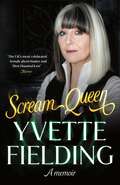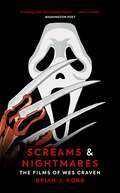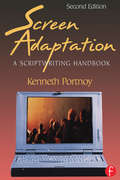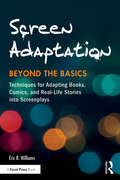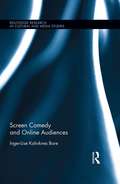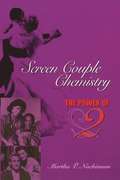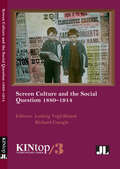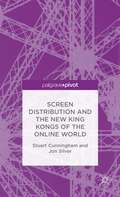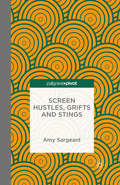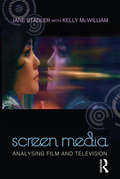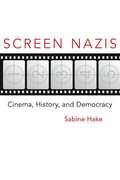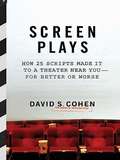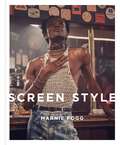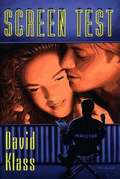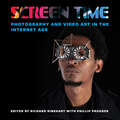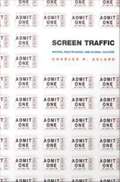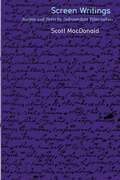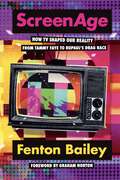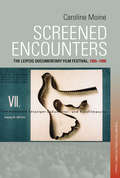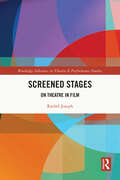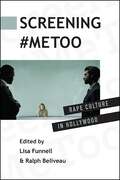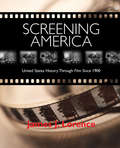- Table View
- List View
Scream Queen: A memoir
by Yvette FieldingSeances, Ouija boards, table tipping, knocking phenomena - all in a day's work for the First Lady of the Paranormal. Yvette Fielding has nerves of steel when facing down her tormentors in the spirit world. Her living-world personal story also reveals a woman of courage and determination, who built success from nothing, following her passion and lifelong curiosity in search of answers to the unexplained.Yvette was always fascinated with the afterlife, and Buddhist meditation practice opened her up to any spirit who wanted to contact her. This manifested in her first family home. Their TV would switch itself on, and kitchen cupboards would open and close all by themselves. When alone there, Yvette would arm herself with a Samurai sword to confront her unseen visitors.But it was a harrowing investigation of eerie 800 year-old Michelham Priory where Yvette’s life-changing Most Haunted adventure began, and still continues many terrifying quests and over twenty years later.Here you’ll walk with Yvette where others fear to tread through chills of the supernatural kind, and she also talks with candid honesty of occasional cold spots she’s encountered in human form. But through all the drops in temperature, the nation’s most celebrated ghost hunter radiates warmth and humour and it’s a joy to accompany her on her incredible journey from child TV star to Most Haunted icon.Beware sceptics: the Scream Queen's story could change your world view for ever.
Screams & Nightmares: The Films of Wes Craven
by Brian J. RobbWriter, producer, and director Wes Craven has successfully tapped into the horror vein for over forty years, serving up scary, funny, cutting-edge thrillers that have become classics in the genre. His films have been both critical and commercial successes, most notably Nightmare on Elm Street, which spawned a series of sequels and made Craven (and his creation, Freddy Kruger) an international sensation. He then created a second indelible series in the horror movie trope with Scream. In Screams & Nightmares, Brian J. Robb examines Craven's entire career, from his low-budget beginnings to his most recent box office hits, from the banned thriller The Last House on the Left and the cult classic The Hills Have Eyes to the outrageous Shocker and The People Under the Stairs. Through exclusive interviews with Craven, Robb provides in-depth accounts of the making of each of the films – including the final installments of the Scream series – Craven's foray into writing novels, and his numerous television projects.
Screen Adaptation: A Scriptwriting Handbook
by Kenneth PortnoyScreen Adaptation : A Scriptwriting Handbook, 2nd ed. examines the challenge screenwriters face when adapting novels, plays, and short stories for the screen. Thoroughly updated to include new exercises and example from current films, this book provides practical, usable information on how to find the best plot line for a script, choose key characters, and understand the goals and formats of different genres. Topics include: determining which characters and events are most valuable on developing the main story;expanding short novellas and condensing long novels;using dialog to advance the story and reveal character;comparing the formats of plays, short stories, and novels to those of screenplaysapproaching the marketplaceIn this book, both beginning writers and professionals will find the tools necessary to evaluate a prospective source and create a successful screenplay
Screen Adaptation: Techniques for Adapting Books, Comics and Real-Life Stories into Screenplays
by Eric R. WilliamsOnce you understand the basics of screenwriting, ideas for your next screenplay are everywhere. Whether it comes from a favorite children’s book, a summer novel you discover accidentally, a news story that catches your imagination, or a chapter from your own life — advanced screenwriting strategies should now guide you through your first adaptation. In Screen Adaptation: Beyond the Basics, award-winning screenwriter Eric Williams uses examples from award-winning screenplays to explain new storytelling techniques. His real-world examples illustrate a range of advanced approaches — including new ways to identify and craft tension, how to reimagine structure and character, and how to strengthen emotional depth in your characters and in the audience. Screen Adaptation: Beyond the Basics teaches readers new ways to engage with source material in order to make successful adaptation decisions, regardless of the source material. The book offers: Three detailed examples of award-winning adaptations by the author, including the complete short story and final scripts used in the Voices From the Heartland project; Breakout boxes highlighting modern and historical adaptations and providing examples for each concept discussed in the book; More than fifty charts providing easy-to-use visual representations of complex concepts; New screenwriting techniques developed by the author, including the Triangle of Knowledge, the Storyteller’s Parallax, and the idea of Super Genres as part of a Screenwriters Taxonomy.
Screen Comedy and Online Audiences (Routledge Research in Cultural and Media Studies)
by Inger-Lise Kalviknes BoreThe question of why we laugh (or don't laugh) has intrigued scholars since antiquity. This book contributes to that debate by exploring how we evaluate screen comedy. What kinds of criteria do we use to judge films and TV shows that are meant to be funny? And what might that have to do with our social and cultural backgrounds, or with wider cultural ideas about film, TV, comedy, quality and entertainment? The book examines these questions through a study of audience responses posted to online facilities such as Twitter, Facebook, review sites, blogs and message boards. Bore’s analysis of these responses considers a broad range of issues, including how audiences perceive the idea of "national" comedy; what they think of female comedians; how they evaluate romcoms, sitcoms and web comedy; what they think is acceptable to joke about; what comedy fans get excited about; how fans interact with star comedians; and what comedy viewers really despise. The book demonstrates some of the ways in which we can adapt theories of humour and comedy to examine the practices of contemporary screen audiences, while offering new insights into how they negotiate the opportunities and constrictions of different online facilities to share their views and experiences.
Screen Couple Chemistry
by Martha P. NochimsonAstaire and Rogers, Tracy and Hepburn. Just the mention of their names evokes the powerful chemistry between these screen couples, which utterly transcended the often formulaic films in which they appeared together. Indeed, watching the synergistic flow of energy between charismatic screen partners is one of the great pleasures of cinema and television, as well as an important vehicle for thinking through issues of intimacy and gender relations. In this book, Martha P. Nochimson engages in a groundbreaking study of screen couple chemistry. She begins by classifying various types of couples to define what sets the synergistic couple apart from other onscreen pairings. Then she moves into extended discussions of four enduring screen couples-Maureen O'Sullivan/Johnny Weissmuller, Myrna Loy/William Powell, Fred Astaire/Ginger Rogers, and Katharine Hepburn/Spencer Tracy. Using theories of neuroscience, she demonstrates that their onscreen chemistry is a very real phenomenon, powerful enough to subvert conventional formulations of male/female relations. Material she has uncovered in the infamous Production Code Administration files illuminates the historical context of her contentions. Finally, Nochimson traces the screen couple to its present-day incarnation in such pairs as Woody Allen/Diane Keaton, Scully/Mulder of The X-Files, and Cliff/Claire Huxtable of The Cosby Show.
Screen Culture and the Social Question, 1880–1914 (KINtop #3)
by Ludwig Vogl-Bienek and Richard CrangleEssays exploring how reformers and charities used the “magic lantern” to raise public awareness of poverty.Public performances using the magic or optical lantern became a prominent part of the social fabric of the late nineteenth century. Drawing on a rich variety of primary sources, Screen Culture and the Social Question, 1880-1914 investigates how the magic lantern and cinematograph, used at public lectures, church services, and electoral campaigns, became agents of social change.The essays examine how social reformers and charitable organizations used the “art of projection” to raise public awareness of the living conditions of the poor and the destitute, as they argued for reform and encouraged audiences to work to better their lot and that of others.
Screen Distribution and the New King Kongs of the Online World
by Stuart Cunningham Jon SilverDrawing on comparisons with historical shake-ups in the film industry, Screen Distribution Post-Hollywood offers a timely account of the changes brought about in global online distribution of film and television by major new players such as Google/YouTube, Apple, Amazon, Yahoo , Facebook, Netflix and Hulu.
Screen Hustles, Grifts and Stings: Stings, Grifts, Hustles and the Long Con
by A. SargeantScreen Hustles, Grifts and Stings identifies recurrent themes and techniques of the con film, suggests precedents in literature and discusses the perennial appeal of the con man for readers and viewers alike. Core studies span from film (Catch Me If You Can, Paper Moon, House of Games) to television (Hustle), from Noir (The Grifters) to Romantic Comedy (Gambit). Frequently, the execution of the con is only finely distinguishable from the conduct of a legitimate profession and, challengingly, a mark is often shown to be culpable in his or her undoing. The best con films, it is suggested, invite re-watching and reward the viewer accordingly: who is complicit and when? How and where is the con achieved? When is the viewer party to the con? And what, if any, moral is to be drawn?
Screen Media: Analysing Film and Television
by Jane Stadler Kelly McWilliamScreen Media offers screen enthusiasts the analytical and theoretical vocabulary required to articulate responses to film and television. The authors emphasise the importance of 'thinking on both sides of the screen'. They show how to develop the skills to understand and analyse how and why a screen text was shot, scored, and edited in a particular way, and then to consider what impact those production choices might have on the audience.Stadler and McWilliam set production techniques and approaches to screen analysis in historical context. They demystify technological developments and explain the implications of increasing convergence of film and television technologies. They also discuss aesthetics, narrative, realism, genre, celebrity, cult media and global screen culture. Throughout they highlight the links between screen theory and creative practice.With extensive international examples, Screen Media is an ideal introduction to critical engagement with film and television.'Screen Media offers a systematic approach to film and television analysis. The examples chosen by the authors are both appropriate and timely, and are presented in a very lively and readable form that will appeal to an international readership.' - Rebecca L. Abbott, Professor of Film, Video + Interactive Media, Quinnipiac University, USA
Screen Nazis
by Sabine HakeFrom the late 1930s to the early twenty-first century, European and American filmmakers have displayed an enduring fascination with Nazi leaders, rituals, and symbols, making scores of films from Confessions of a Nazi Spy (1939) and Watch on the Rhine (1943) through Des Teufels Gentral (The Devil's General, 1955) and Pasqualino settebellezze (Seven Beauties, 1975) up to Der Untergang (Downfall, 2004), Inglourious Basterds (2009), and beyond.
Screen Plays: How 25 Scripts Made It to a Theater Near You--for Better or Worse
by David S. CohenIn this fascinating survey of contemporary screen craft, David Cohen of Script and Variety magazines leads readers down the long and harrowing road every screenplay takes from idea to script to screen. In interviews with Hollywood screenwriters from across the board-Oscar winners and novices alike-Cohen explores what sets apart the blockbuster successes from the downright disasters. Tracing the fortunes of twenty-five films, including Troy, Erin Brockovich, Lost in Translation, and The Aviator, Cohen offers insider access to back lots and boardrooms, to studio heads, directors, and to the over-caffeinated screenwriters themselves. As the story of each film evolves from the drawing board to the big screen, Cohen proves that how a script is written, sold, developed, and filmed can be just as dramatic and intriguing as the movie itself-especially when the resulting movie is a fiasco. Covering films of all kinds-from tongue-in-cheek romps like John Waters's A Dirty Shame to Oscar winners like Monster's Ball and The Hours-Screen Plays is an anecdote-filled, often inspiring, always revealing look at the alchemy of the movie business. With Cohen as your expert guide, Screen Plays exposes how and why certain films (such as Gladiator) become "tent poles," those runaway successes every studio needs to survive, and others become train wrecks. Full of critical clues on how to sell a script-and avoid seeing it destroyed before the director calls Action!-it's the one book every aspiring screenwriter will find irresistible.
Screen Style
by Marnie FoggScreen Style celebrates the beautiful, stylish and often covetable outfits and costumes featured in 50 iconic and diverse series of the small screen: from Mad Men to Call My Agent, Bridgerton to Empire.By organising the series into genres - Comedy, Coming of Age, Crime, Historical, Retro, Contemporary - the author shows how designers take different approaches when manipulating the latent power of dress to create convincing characters and enhance the experience of the viewer. She reveals how the characters themselves can become role models for what to wear, transforming actors into fashion influencers.The book is beautifully illustrated with over 250 screen stills, each accompanied by an extended caption, further demonstrating how TV series have helped to set the standard for fashion on and off screen.
Screen Style
by Marnie FoggScreen Style celebrates the beautiful, stylish and often covetable outfits and costumes featured in 50 iconic and diverse series of the small screen: from Mad Men to Call My Agent, Bridgerton to Empire.By organising the series into genres - Comedy, Coming of Age, Crime, Historical, Retro, Contemporary - the author shows how designers take different approaches when manipulating the latent power of dress to create convincing characters and enhance the experience of the viewer. She reveals how the characters themselves can become role models for what to wear, transforming actors into fashion influencers.The book is beautifully illustrated with over 250 screen stills, each accompanied by an extended caption, further demonstrating how TV series have helped to set the standard for fashion on and off screen.
Screen Test
by David KlassWhile starring in her first feature film, sixteen-year-old Liz is dazzled by Los Angeles and a charming and handsome leading man and wonders what it will be like to return to her normal life in New Jersey.
Screen Time: Photography and Video Art in the Internet Age
by Richard Rinehart and Phillip ProdgerPublished on the occasion of the art exhibition Screen Time: Photography and Video Art in the Internet Age, this catalog features a selection of leading international artists who engage with and critique the role of media in contemporary society. Their work demonstrates what has become known as post-internet artistic practices—art that may or may not be made for the internet but nevertheless acknowledges online culture as an omnipresent influence, inseparable from contemporary social conditions. They ask what it means to be a photographer when everyone is an Instagram influencer; what it means to make video art when everyone is a TikTok video star; and how to deliver meaningful social commentary in the age of the meme. The exhibition and accompanying catalog showcase artwork by N. Dash, Nathalie Djurberg, Marcel Dzama, Peter Funch, Cyrus Kabiru, William Kentridge, Christian Marclay, Marilyn Minter, Vik Muniz, Otobong Nkanga, Erwin Olaf, Robin Rhode, Vee Speers, Mary Sue, Puck Verkade, Huang Yan. Published by Bucknell University Press for the Samek Art Museum. Distributed worldwide by Rutgers University Press.
Screen Traffic: Movies, Multiplexes, and Global Culture
by Charles R. AclandIn Screen Traffic, Charles R. Acland examines how, since the mid-1980s, the U. S. commercial movie business has altered conceptions of moviegoing both within the industry and among audiences. He shows how studios, in their increasing reliance on revenues from international audiences and from the ancillary markets of television, videotape, DVD, and pay-per-view, have cultivated an understanding of their commodities as mutating global products. Consequently, the cultural practice of moviegoing has changed significantly, as has the place of the cinema in relation to other sites of leisure. Integrating film and cultural theory with close analysis of promotional materials, entertainment news, trade publications, and economic reports, Acland presents an array of evidence for the new understanding of movies and moviegoing that has developed within popular culture and the entertainment industry. In particular, he dissects a key development: the rise of the megaplex, characterized by large auditoriums, plentiful screens, and consumer activities other than film viewing. He traces its genesis from the re-entry of studios into the movie exhibition business in 1986 through 1998, when reports of the economic destabilization of exhibition began to surface, just as the rise of so-called e-cinema signaled another wave of change. Documenting the current tendency toward an accelerated cinema culture, one that appears to arrive simultaneously for everyone, everywhere, Screen Traffic unearths and critiques the corporate and cultural forces contributing to the "felt internationalism" of our global era.
Screen Writings: Texts and Scripts from Independent Films
by Scott MacDonald"Ask audience to cut the part of the image on the screen that they don't like. Supply scissors."—Yoko Ono, Tokyo, June 1964A dazzling range of unconventional film scripts and texts, many published for the first time, make up Scott MacDonald's newest collection. Illustrated with nearly 100 film stills, this fascinating book is at once a reference work of film history and an unparalleled sampling of experimental "language art." It contributes to the very dissipation of boundaries between cinematic, literary, and artistic expression thematized in the films themselves. Each text and script is introduced and contextualized by MacDonald; a filmography and a bibliography round out the volume.This is a readable—often quite funny—literature that investigates differences between seeing and reading. Represented are avant-garde classics such as Hollis Frampton's Poetic Justice and Zorns Lemma and Morgan Fisher's Standard Gauge, and William Greaves's recently rediscovered Symbiopsychotaxiplasm: Take One. Michael Snow turns film loose on language in So Is This; Peter Rose turns language loose on theory in Pressures of the Text.Some of the most influential feminist filmscripts of recent decades—Laura Mulvey and Peter Wollen's Riddles of the Sphinx, Su Friedrich's Gently Down the Stream, Trinh T. Minh-ha's Reassemblage, Yvonne Rainer's Privilege—confirm this book's importance for readers in gender and cultural studies as well as for filmmakers and admirers of experimental writing, independent cinema, and the visual arts in general.
ScreenAge: How TV shaped our reality, from Tammy Faye to RuPaul’s Drag Race
by Fenton Bailey'Like a superheated kernel of corn, the world has gone Pop... Drag has become mainstream. Being gay became cool. From being the criminal outsider, being queer has even become representative of the way the outsider voice is common to us all.'When he moved to New York in 1982, Fenton Bailey saw the world go Pop. Together with filmmaking partner Randy Barbato, their production company World of Wonder would pioneer the genre of Reality TV and chronicle the emerging Screen Age through their extraordinary programs and outrageous subjects - from Bible Belt televangelists and conspiracy theories to pioneering drag queens.Working with icons such as Britney Spears, Tammy Faye Bakker and RuPaul, the production company's shows tell a wider story of how television has fundamentally shifted our reality.Packed with glorious insider gossip and amazing celebrity stories, these are the riotous tales behind the shows that would make ScreenAgers of us all.
Screened Encounters: The Leipzig Documentary Film Festival, 1955-1990 (Film and the Global Cold War #1)
by Caroline MoineEstablished in 1955, the Leipzig International Documentary Film Festival became a central arena for staging the cultural politics of the German Democratic Republic, both domestically and in relation to West Germany and the rest of the world.�Screened Encounters�represents the definitive history of this key event, recounting the political and artistic exchanges it enabled from its founding until German unification, and tracing the outsize influence it exerted on international cultural relations during the Cold War.
Screened Encounters: The Leipzig Documentary Film Festival, 1955-1990 (Visual and Media Cultures of the Cold War and Beyond)
by Caroline MoineEstablished in 1955, the Leipzig International Documentary Film Festival became a central arena for staging the cultural politics of the German Democratic Republic, both domestically and in relation to West Germany and the rest of the world. Screened Encounters represents the definitive history of this key event, recounting the political and artistic exchanges it enabled from its founding until German unification, and tracing the outsize influence it exerted on international cultural relations during the Cold War.
Screened Stages: On Theatre in Film (ISSN)
by Rachel JosephThis book is devoted to tracing the variety of ways that theatre, theatricality, and performance are embedded in Hollywood cinema as screened stages.A screened stage is the literal or metaphorical appearance of a stage on screen. When the Hollywood style emerged in cinema history it traumatically severed the entwined relationship between film and theatre. The book makes the argument that cinema longs for theatre after that separation. The histories of stage and screen persistently crisscross one another making their separation problematic. The screened stage from the end of the nineteenth century until now offers a miniaturized version of cinema and theatre history. Moments of the stage within the screen compress historical styles and movements into saturated representations on film. Such examples overflow the cinematic screen into singular manifestations of presentness. Screened stages uncover what it means to be simultaneously present and absent.This book would be of great interest to students and scholars of theatre, film, dance, and performance.
Screening #MeToo: Rape Culture in Hollywood
by Lisa Funnell Ralph BeliveauScreening #MeToo offers an important and timely discussion of the pervasive nature of rape culture in Hollywood. Essays in the collection examine films released from the 1960s onward, a broad period that coincides with the end of the Motion Picture Production Code in Hollywood, which resulted in more frequent and increasingly graphic images of sex and violence being included in mainstream movies. Focusing on narratives in which surveillance and sexual violence feature prominently, contributors from North America and Europe examine a variety of film genres, including spy films, teen comedies, kitchen sink dramas, coming-of-age stories, rape/revenge films, and horror films. Reflecting the increasing social and academic awareness of sexual violence in Hollywood film and its transmission and cultivation of rape culture in the United States and abroad, they are concerned not only with the content of the films under scrutiny but also with the clear relationship between the stories, how they are being told, and the culture that produced them. Screening #MeToo challenges readers to look at mainstream Hollywood films differently, in light of attitudes about art and power, sexuality and consent, and the pleasures and frustrations of criticizing "entertainment" films from these perspectives.
Screening America: United States History through Film since 1900
by James J LorenceBy combining the study of films with the text-based primary sources, Screening America gives students clear guidance in studying, interpreting, and understanding the motion picture's significance as a primary source in investigating U.S. History.Students will come to understand history as not only the record of what governments did, but also the way in which people lived their lives, experienced the wider world, and engaged in leisure pursuits, from which we can learn much about the society in which they lived.
Screening American Independent Film (Screening Cinema)
by Justin Wyatt W. D. PhillipsThis indispensable collection offers 51 chapters, each focused on a distinct American independent film. Screening American Independent Film presents these films chronologically, addressing works from across more than a century (1915−2020), emphasizing the breadth and long duration of American independent cinema. The collection includes canonical examples as well as films that push against and expand the definitions of "independence." The titles run from micro-budget films through marketing-friendly Indiewood projects, from auteur-driven films and festival darlings to B-movies, genre pics, and exploitation films. The chapters also introduce students to different approaches within film studies including historical and contextual framing, industrial and institutional analysis, politics and ideology, genre and authorship, representation, film analysis, exhibition and reception, and technology. Written by leading international scholars and emerging talents in film studies, this volume is the first of its kind. Paying particular attention to issues of diversity and inclusion for both the participating scholars and the content and themes within the selected films, Screening American Independent Film is an essential resource for anyone teaching or studying American cinema.
